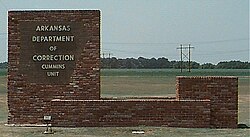History
All but four executions carried out before 1913 were by hanging. Four guerillas were shot on July 29, 1864.
On July 25, 1902, seven men were hanged, the most executions in one day in the state.
Almost all executions were for crimes that involved murder. A number of people were also executed for rape and there was one execution for espionage, 17-year-old alleged Confederate spy David O. Dodd, hanged by Union soldiers on January 8, 1864.
In 1913, the method used was changed to the electric chair. The electric chair was constructed from the wood that had previously made up the state gallows. This electric chair would be used for all electrocutions up until 1964. Four more people were hanged in the state — one in 1913, two in 1914 and one in 1930.
The last execution in the state before Furman v. Georgia [1] was that of Charles Fields on January 24, 1964 for rape. New capital punishment laws were passed in Arkansas and came into force on March 23, 1973. The first execution would not come until June 18, 1990 when John Edward Swindler was electrocuted. His was the first and so far only execution using an electric chair constructed by the state in the 1970s.
According to Michael L. Radelet of the University of Colorado there have been two instances of executions that did not go according to plan in Arkansas since Furman. On January 24, 1992, the execution of Ricky Ray Rector was delayed by fifty minutes after the medical staff were unable to find a suitable vein in his arm. The curtain over the witness area was not drawn, and witnesses heard Rector moan loudly eight times. State officials attributed the difficulties to his size and use of antipsychotic medication. The execution of Christina Marie Riggs faced similar delays on May 2, 2000, when staff were unable to locate a vein in her elbow. They eventually found one in her wrist.
There have been at least three death row volunteers in Arkansas: Ronald Gene Simmons, Christina Marie Riggs, and Clay King Smith.
In April 2017, the state planned to execute eight death row inmates before the stocks of the sedative midazolam expired at the end of April, but ultimately only four were put to death that month. A federal judge initially issued an injunction preventing the executions, but the Eight Circuit Court of Appeals overturned the ruling and the United States Supreme Court rejected a claim that the accelerated execution schedule was "cruel and unusual punishment." [2] On April 20, at about 11:30 PM CST, they were allowed to proceed. At 11:56 PM CST, four minutes prior to the expiration of his execution warrant, Ledell Lee was executed, making him the first inmate in Arkansas to be executed since 2005. [3] On April 24, Jack Harold Jones and Marcel Williams were executed, the first double execution in the United States in 17 years. [4] The last of the four inmates put to death in April 2017 was serial killer Kenneth Williams, who was found guilty of murdering a farmer during his prison escape and sentenced to death; Williams was also convicted of two more murders but was given two life sentences for these other killings. Williams, whose death sentence was carried out on April 27, 2017, remains the last person executed in Arkansas as of 2024. [5]
In February 2025, a bill was proposed to allow the state to execute criminals by nitrogen hypoxia, a method first used by Alabama in 2024 to execute four of its condemned inmates between January 2024 and February 2025. [6] A legislative panel voted 10-5 to grant approval to the Bill, and it advanced to the House for further review. [7] The bill swiftly passed in the Arkansas House of Representatives by a majority vote of 67-23 on March 4, 2025, [8] The bill passed in the Arkansas Senate by a majority vote of 26-9 on March 11, 2025. [9] The Arkansas governor Sarah Huckabee Sanders signed the bill into law on March 18, 2025. Arkansas became the fifth state in the US joining Alabama, Oklahoma, Mississippi, and Louisiana to allow executions by nitrogen hypoxia. [10]
Legal process
When the prosecution seeks the death penalty, the sentence is decided by the jury and must be unanimous.
In case of a hung jury during the penalty phase of the trial, a life sentence is issued, even if a single juror opposed death (there is no retrial). [11]
The Governor of Arkansas has the power of clemency with respect to death sentences. [12] The governor receives for that purpose a non-binding report from the Arkansas Board of Pardons and Paroles.
The methods of execution are lethal injection and nitrogen hypoxia. Anyone sentenced to death before July 4, 1983 can choose between lethal injection, nitrogen hypoxia, and electrocution, [13] however, currently there aren't any death row inmates that were sentenced before the aforementioned date. [14] If lethal injection and nitrogen hypoxia are ever ruled unconstitutional, electrocution shall be used to replace them. [15]
Executions in Arkansas are currently performed at the Cummins Unit.

